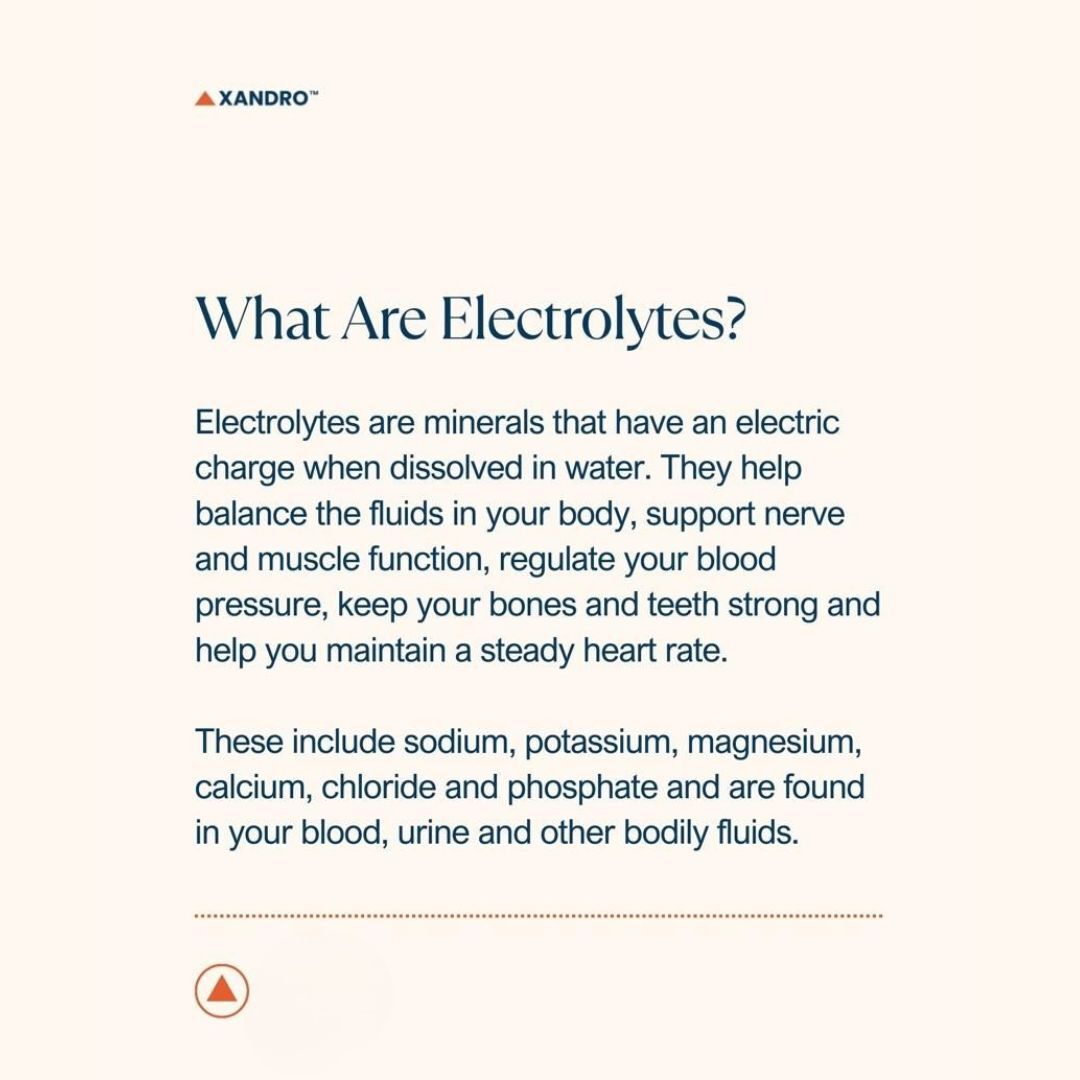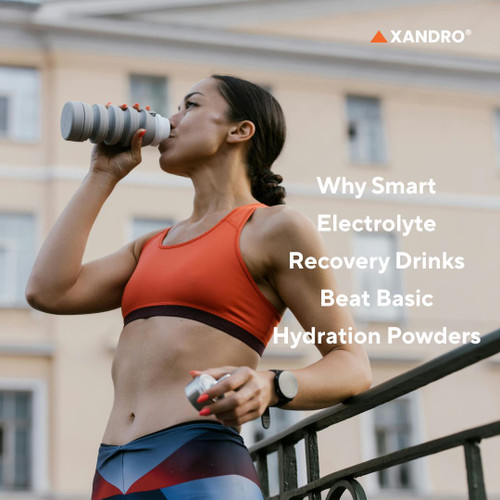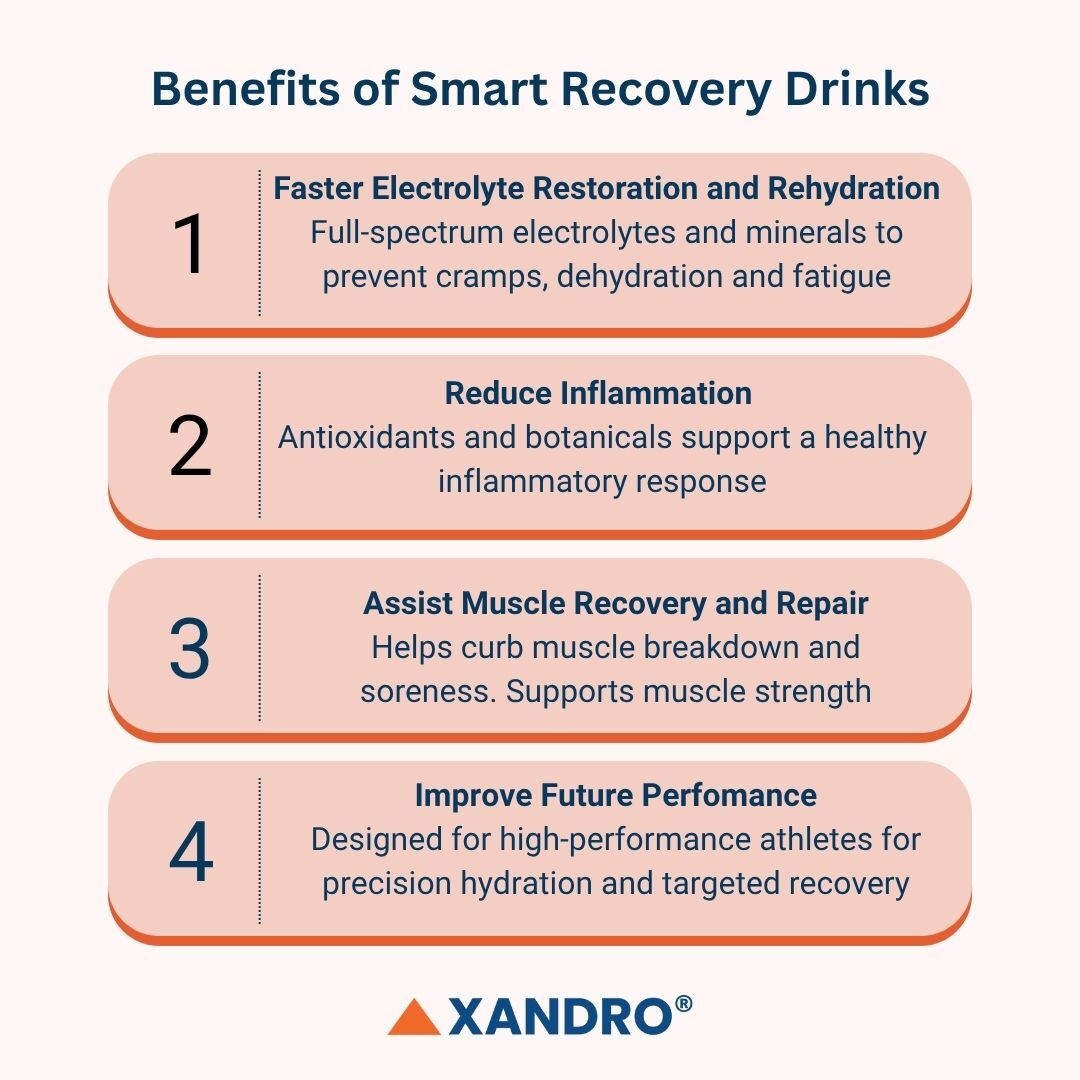Why Smart Electrolyte Recovery Drinks Beat Basic Hydration Powders
12th Aug 2025
For elite athletes, recovery is the new competitive edge. These high performers now recognize that success isn’t just about training harder – it’s about recovering smarter. Enhanced recovery enables more training volume, fewer injuries, and better adaptation.
At the center of this evolution is smart hydration – not as an afterthought, but as a foundational pillar of performance strategy.
Jump there now:
Why Hydration Alone Falls Short
Hydration vs. Recovery: Understanding the Gap
How much sodium do you need if you exercise hard?
Basic Hydration Powders vs Smart Recovery Drinks: The Difference
Who Are Smart Recovery Drinks Really For?
How to Get the Most Out of Smart Recovery Drinks
Smarter Recovery Formula: The Science Behind Xandro E+R Recovery Electrolyte
Products mentioned in this blog:
Why Hydration Alone Falls Short
Hydration is undeniably important. In fact, losing just a modest 2% drop in body water (considered mild dehydration) can impact physical performance and endurance, slow reaction time, make it harder to regulate body temperature regulation, and blunt cognitive performance.
During tough workouts – especially in hot and humid conditions – it’s not unusual to lose between 1-4 liters of sweat.
But for athletes who constantly push their bodies to the limit, replacing water alone isn’t enough. Maintaining proper fluid and electrolyte balance is critical – and should be seen as a core part to any training or recovery strategy
The problem with standard hydration powders is that they usually only replace water and basic minerals like sodium and potassium. They fail to address the bigger picture of recovery following intense exertion: things like muscle microtrauma, oxidative stress, inflammation, and how your body bounces back the next day.
Hydration vs. Recovery: Understanding the Gap

Electrolytes like sodium, potassium, and magnesium are essential for your muscle and nerve function. They help send the signals your body relies on to control muscle movement and nerve impulses. When your electrolyte levels are imbalanced, the body’s electrical systems misfire, causing things like cramps, fatigue, poor coordination and sluggish performance.
Symptoms of Electrolyte Imbalances
When your electrolyte levels get too low or too high, your body gives you warning signals:
|
Electrolyte |
Too Low |
Too High |
|
Sodium |
Fatigue, headache, foggy thinking |
Thirst, puffiness, raised blood pressure |
|
Potassium |
Muscle cramping, heart palpitations |
Nausea, chest pain, muscle weakness |
|
Magnesium |
Fatigue, muscle twitches |
Low blood pressure, irregular heartbeat |
|
Calcium |
Numbness, muscle spasms |
Constipation, bone pain |
In short: without proper electrolyte balance, performance and coordination suffer.
How much sodium do you need if you exercise hard?
There’s no one-size-fits-all answer here.
For most of healthy adults, a typical duet easily provides the ~500 mg daily sodium needed every day to support hydration, nerve function, and muscle contractions.
Public health guidelines recommend keeping total daily intake to around 2,000–2,300 mg, and even lower (around 1,500 mg) if you have high blood pressure or are salt-sensitive.
But if you’re an athlete, your needs are different.
Let’s say you’re doing a light jog or a 5K – you probably don’t need to worry about sodium loss, unless:
- it’s under hot and humid conditions
- you’re a heavy or salty sweater
You might be a “salty sweater” if:
- You notice white salt stains on your clothes or gear
- Your skin feels gritty or crusty post-workout
- You regularly feel drained after sessions in heat
Some athletes lose 1,500–2,000 mg of sodium with every liter of sweat. And under extreme heat or exertion, this can climb to 3,000–4,000 per hour. That kind of loss can disrupt your fluid balance, mess with muscle function, and seriously slow down your recovery.
Balanced fluid and electrolyte replacement is essential if you’re doing endurance sports like marathons and triathlons, are a performance-driven trainer, or training multiple times a day.
Fluid without sodium can dilute blood sodium levels, increasing risks of cramps, fatigue, and even exercise-associated hyponatremia (overhydration). Mild symptoms include headache, dizziness, weakness, lethargy, nausea, and vomiting – and, in rare cases, severe complications.
Best practices to stay ahead:
- Before/during sessions: Sip recovery drinks with a full range if electrolytes – sodium, chloride, magnesium
- Personalize your hydration using sweat patch testing or measure how much fluid you lose per session to better personalize your hydration strategy through sweat rate tracking
Curious about what happens when your body is low on electrolytes? Dive deeper into the symptoms and ways to stay balanced.
Basic Hydration Powders vs Smart Recovery Drinks: The Difference
Recovery and high performance demand more than fluid replacement. It needs targeted support for:
- Muscle repair
- Inflammation reduction
- Cellular resilience
That's where advanced recovery drinks come into play.
Basic hydration powders typically contain sodium, potassium, and water – sometimes with an added dose of sugar. They’re fine for avoiding dehydration or minor cramping but fall short when it comes to helping your body actually recover from tough sessions.
Smart recovery drinks aren’t just hydration aids, they’re recovery accelerators. These drinks work like a post-workout toolkit, providing:
- A full range of electrolytes
- Branched-chain amino acids (BCAAs) to help rebuild muscle
- Botanicals that fight inflammation and oxidative stress so you recover faster and more fully
Power partnerships matter
It’s not just what’s in a recovery drink – it’s how those ingredients work together that counts. Smart recovery drinks often pair:
- Electrolytes – to restore fluid balance, reduce cramping, and support proper muscle and nerve function
- BCAAs, which kickstart muscle rebuilding, reduce post-workout breakdown, and help you stay mentally sharp when fatigue sets in
Together, they rehydrate the body while actively assisting with repair, resulting in faster recovery and better performance in their next session.

PULL QUOTE: Smart hydration is no longer optional; it's a cornerstone of high-performance strategy.
Who Are Smart Recovery Drinks Really For?
As mentioned earlier, for most folks, drinking water and eating a balanced diet usually keeps hydration in check. But if you’re regularly facing high physical demands or extreme conditions, basic hydration might not be enough.
Smart recovery drinks are ideal for:
- Endurance athletes who log long training hours
- CrossFitters or gym-goers doing two-a-days
- Hikers tackling multi-hour or multi-day treks
- Anyone working in hot, sweat-heavy environments
How to Get the Most Out of Smart Recovery Drinks
If you’re working out in the heat or doing long, intense sessions, staying ahead of dehydration is essential. The CDC recommends drinking fluids every 15–20 minutes during intense exertion and prolonged sweating, suggesting the use of balanced electrolyte drinks.
Quick tip: Your urine color is a simple hydration check – the paler, the better.
Salty foods and snacks can help meet your electrolyte needs during activity, but for longer events or back-to-back sessions, smart recovery drinks do a better job of keeping your muscles and nervous system functioning at their best.
Best practices:
- Sip throughout training rather than chugging large volumes afterward
- Use after exercise to support muscle repair
- Choose clean, low-sugar formulas to avoid GI discomfort
Building a Smarter Recovery Formula: The Science Behind Xandro E+R Recovery Electrolyte
The best recovery drinks don’t just hydrate—they help your body fight inflammation and rebuild muscle, too. That’s exactly what Xandro’s E+R Recovery Electrolyte is designed to do: hydrate effectively, speed up recovery, and support peak performance, all in one formula.
Complete Electrolyte Complex: Hydration, Nerve Function, and Muscle Performance
A full spectrum of essential minerals – magnesium, calcium, zinc, chloride, sodium, and potassium, plus a hit of vitamin C.
Research-backed benefits:
- Restore fluid and electrolyte balance: Sodium and chloride help your body retain water and prevent hyponatremia during intense sweat loss1
- Support muscle contraction and recovery: Magnesium and calcium are essential for neuromuscular coordination and cramp prevention2
- Enhance immune and antioxidant function: Vitamin C plays a key role in immune defense and counteracting exercise-induced oxidative stress3
Maintain cardiovascular and nerve function: Potassium supports heart rhythm and intracellular hydration balance4
Branched-chain amino acids (BCAAs): Muscle repair and fatigue resistance
The essential amino acids leucine, isoleucine, and valine are metabolized directly in muscle – making them uniquely suited for exercise recovery.
Research-backed benefits:
- Stimulate muscle protein synthesis (via mTOR activation)5,6
- Reduce exercise-induced muscle breakdown
- May delay central fatigue by regulating serotonin pathways7
- Reduce muscle soreness and accelerate recovery8
Ideal for: fasted training, intense volume blocks, or low-protein dietary windows.
Recoverben®: Natural, clinically supported anti-inflammatory
Recoverben® is a clinically supported natural lemon verbena extract packed with polyphenols – plant compounds known for fighting inflammation. It helps reduce exercise-induced inflammation and oxidative stress without the harsh side effects of NSAIDs.
Clinically shown to:
- Reduce post-exercise inflammation and delayed-onset muscle soreness (DOMS)9
- Enhance antioxidant capacity9
- Accelerate recovery from DOMS9
Clean, effective, athlete-first approach
Every ingredient in Xandro E+R is chosen with purpose – no fluff, no junk:
- No fillers, stimulants, caffeine, or artificial sweeteners
- Naturally sweetened with monkfruit and thaumatin
- Suitable for keto, low-carb and paleo diets
- GI-friendly formula
- Backed by clinical research, 100% bioavailable ingredients
End Notes
If you're the type of athlete who’s always chasing progress – whether you're logging long runs, crushing CrossFit WODs, or grinding through double sessions – then your recovery plan needs to keep pace.
Don’t stop at hydration. Support your body with a recovery drink designed to reduce soreness, restore minerals, and help your muscles rebuild, to help you bounce back faster and stronger, , and feel better doing it.
Further Reading: The Power of Hydration & Electrolytes
References
- Medline Plus: Fluid and Electrolyte Balance
- Volpe, S.L. (2007). Magnesium and the Athlete. Current Sports Medicine Reports, 6(1), 21–25.
- Walsh NP (2019). Nutrition and Athlete Immune Health: New Perspectives on an Old Paradigm. Sports Med.,153-168.
- Kowey, P.R. (2002). The Role of Potassium. In: Lobo, R.A., Crosignani, P.G., Paoletti, R., Bruschi, F. (eds) Women’s Health and Menopause. Medical Science Symposia Series, vol 17.
- Xu M, et al (2025). Branched-Chain Amino Acids and Inflammation Management in Endurance Sports: Molecular Mechanisms and Practical Implications. Nutrients.
- Norton, L.E. & Layman, D.K. (2006). Leucine regulates translation initiation of protein synthesis in skeletal muscle after exercise. The Journal of Nutrition, 136(2), 533S–537S.
- Blomstrand, E., et al. (1997). Administration of branched-chain amino acids during sustained exercise. American Journal of Physiology, 273(4), E814–E820.
- Jackman, S.R., et al. (2010). Branched-chain amino acid ingestion can ameliorate soreness from eccentric exercise. Journal of Sports Science & Medicine, 9(4), 547–552.
- Buchwald-Werner, S., Naka, I., Wilhelm, M. et al. (2018). Effects of lemon verbena extract (Recoverben®) supplementation on muscle strength and recovery after exhaustive exercise: a randomized, placebo-controlled trial. J Int Soc Sports Nutr 15, 5.
FAQs
Can I drink smart electrolyte recovery drinks every day?
If you're training regularly, live in a hot climate, or work in physically demanding environments, using smart electrolyte drinks daily can support hydration, recovery, and performance. However, for rest days or light activity, most people can maintain electrolyte balance through food and water alone. It’s about matching intake to demand – not overloading when it’s not needed.
Do I need electrolytes if I’m not an elite athlete?
You don’t need advanced recovery drinks for a casual 30-minute walk. But if you're doing intense workouts, fasted training, or long endurance sessions, electrolytes become crucial. They help prevent fatigue, cramps, and performance drops by supporting hydration, muscle function, and fluid balance.
How do smart electrolyte drinks help beyond hydration?
Unlike basic sports drinks, smart recovery drinks support muscle repair, inflammation control, and performance rebound. They include branched-chain amino acids (BCAAs) for muscle recovery, botanical anti-inflammatories like Recoverben®, and full-spectrum electrolytes to address neuromuscular and cellular function – not just thirst.
What’s the best way to use recovery drinks during intense training or heat?
During long sessions or work in hot environments, aim to sip fluids every 15–20 minutes rather than wait until you're thirsty. Prioritize electrolyte-rich beverages if you're sweating heavily or doing back-to-back efforts. For multi-hour events, combining recovery drinks with light snacks or amino acid support can also aid sustained performance.
Will smart electrolyte drinks break my fast?
Most low-carb or sugar-free electrolyte recovery drinks will not break a fast, especially if they don’t contain calories or insulin-spiking sweeteners. However, always check the label – some products include sugars, flavors, or hidden fillers. Look for clean-label options with electrolytes, BCAAs, and botanicals, not carb-loading ingredients.
How fast can I replenish electrolytes after a workout?
You can begin restoring electrolyte balance within 30–60 minutes post-workout. Drinking a smart recovery formula with sodium, potassium, and magnesium – plus BCAAs – will help reduce cramping, improve fluid uptake, and support muscle strength retention into your next session. Foods like bananas, nuts, and lightly salted meals can complement your drink.
Can I use smart recovery drinks when sick or dehydrated?
Yes – smart electrolyte drinks can help during illness-related dehydration, especially if you’ve been vomiting, have diarrhea, or are experiencing muscle fatigue. The amino acids and botanicals in advanced formulas may also help ease soreness and rebuild immune resilience, but always consult a healthcare provider if symptoms persist.
What’s the difference between a sports drink and a smart recovery drink?
Most traditional sports drinks focus on sugar and sodium. They’re designed for fueling energy, not muscle recovery. In contrast, smart recovery drinks deliver clinically backed ingredients to aid hydration, reduce inflammation, and promote muscle repair – without the excess sugar, fillers, or artificial additives.

